By Edelmiro
In the grand chessboard of the internet, not all pieces move freely. Geo-restrictions—digital borders that limit access to content based on your physical location—can leave even the keenest minds in check. Enter the humble proxy: a tool as old as network engineering itself, now refined for the nuanced strategies of the modern web. Let’s methodically examine how proxies help us sidestep these barriers, combining the steady pulse of classic radio relays with the deft maneuvering of a well-played Sicilian Defense.
What Is a Proxy?
Think of a proxy server as a relay station, much like those used by early radio operators. Instead of transmitting Morse code, a proxy forwards your internet requests, making them appear as though they originate from another location. In essence:
- You → Proxy Server → Website/Service
When a site sees the proxy’s location instead of yours, the geo-barrier may vanish, unveiling previously restricted content.
Why Are Some Content Geo-Restricted?
The reasons are as varied as chess openings:
- Licensing agreements: Media companies may only have rights to stream content in certain countries.
- Legal regulations: Some governments restrict access to specific information.
- Market segmentation: Businesses tailor products and pricing by region.
The result? A digital landscape of walled gardens, open only to those with the right credentials—or the right tools.
Types of Proxies: A Comparative Gambit
There’s no single proxy to rule them all. Each has its strengths, weaknesses, and ideal scenarios—much like chess pieces.
1. HTTP/HTTPS Proxies
- What: Handle web traffic (HTTP/HTTPS only)
- Best for: Browsing websites, streaming video
- Analogy: Like a pawn—simple, but effective in the right formation
2. SOCKS Proxies
- What: Route any type of internet traffic (not just web)
- Best for: Torrents, games, or apps needing more than just web browsing
- Analogy: The knight—versatile, able to jump over obstacles
3. Transparent Proxies
- What: Intercept traffic without any user configuration
- Best for: Filtering or caching (often used by institutions)
- Analogy: The bishop—quietly influencing play from the background
4. Residential Proxies
- What: Use real devices’ IP addresses
- Best for: Avoiding detection by streaming services
- Analogy: The queen—powerful and difficult to block
How Proxies Bypass Geo-Restrictions: The Opening Move
Imagine you’re in Paris, but the show you want is available only to viewers in New York. By connecting through a proxy server located in New York, you can make the streaming service believe you’re sipping coffee in Manhattan, not Montmartre.
Step-by-step:
- Choose a proxy server in your desired country.
- Configure your device (browser, app, or system settings) to use the proxy.
- Browse as usual. The destination site sees the proxy’s IP, not yours.
Tip: Some streaming services are adept at proxy-detection. Like a seasoned chess player, they anticipate common moves. Residential proxies, with their authentic IPs, are often harder to detect.
Proxies vs. VPNs: Two Sides of the Same Board
While proxies and VPNs both reroute your traffic, their methods diverge:
| Feature | Proxy | VPN |
|---|---|---|
| Encryption | Rare (usually not encrypted) | Encrypts all traffic |
| Scope | Per-app or per-browser | System-wide |
| Speed | Generally faster (less overhead) | Slightly slower (due to encryption) |
| Cost | Often cheaper or free | Usually paid |
| Privacy | Lower (ISP can see traffic) | Higher (all traffic is hidden from ISP) |
Analogy: Proxies are like tuning a single radio frequency; VPNs are akin to shielding the entire transmitter.
Setting Up a Proxy: Step-by-Step Guide
-
Select a reliable proxy provider.
Tip for advanced users: Rotate proxies automatically for enhanced anonymity. -
Obtain the proxy address and port.
-
Configure your application or operating system:
- In browsers: Settings → Network → Proxy
- In Windows: Control Panel → Internet Options → Connections → LAN Settings
-
In MacOS: System Preferences → Network → Advanced → Proxies
-
Test your connection. Visit whatismyip.com to confirm you appear in the desired location.
Risks and Limitations: Avoiding a Blunder
Like a miscalculated chess move or a radio signal lost to static, poor proxy choices can backfire.
- Data security: Many free proxies log your traffic. Avoid sending sensitive information.
- Connection speed: Some proxies slow down your connection.
- Detection: Advanced services may blacklist known proxy IPs.
- Legal implications: Circumventing geo-restrictions may violate terms of service.
Pro Tip for Advanced Users: Consider combining proxies with other privacy tools (such as Tor or VPNs) for a layered defense—much like castling for king safety.
Conclusion: The Endgame
Using proxies to access geo-restricted content is a time-honored tactic, blending the precision of radio relays with the strategic finesse of chess. For simple browsing or complex operations, the right proxy—chosen and deployed thoughtfully—can open up a world otherwise locked behind digital borders. Play your pieces wisely, and the board is yours.
As any engineer or chess player will tell you: success lies not just in knowing the tools, but in knowing when and how to use them.

Comments (0)
There are no comments here yet, you can be the first!